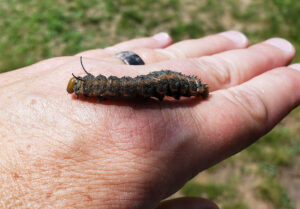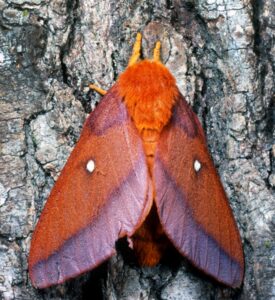
This large caterpillar, a pink-striped oakworm, has great camouflage and blends in with oak twigs very well. / Photo Credit: Linda Williams, Wisconsin DNR
By Linda Williams, DNR Forest Health Specialist, Woodruff;
Linda.Williams@wisconsin.gov or 920-360-0665
Pink-striped oakworm is a native fall defoliator. Fall defoliators affect the health of trees less than defoliators that occur in the spring.
Although literature states that high populations of this caterpillar can create significant defoliation, no defoliation was noted in the area this caterpillar was observed in Oneida County.

An adult pink-striped oakworm moth (Anisota virginiensis) rests on a tree. / Photo Credit: Sturgis McKeever, Georgia Southern University, Bugwood.org
Depending on the source, pink-striped oakworm is either classified as three subspecies of the same species or as three different species. No matter how it is classified, the northern variety calls Wisconsin home. This variety feeds primarily on northern red oak, although it will feed on any oak if necessary.
In recent years, pink-striped oakworm numbers have been low in Wisconsin.
The individual caterpillar pictured did not seem very vigorous. Based on a swollen area on the body, it may have been parasitized. A number of parasitoids target large caterpillars; there is some literature that says Compsilura concinnata will attack pink-striped oakworm. Compsilura concinnata is an invasive tachinid fly.
While these flies are better known for attacking spongy moths in the spring, they also seek a fall-feeding caterpillar for the overwintering part of their life cycles, so pink-striped oakworm can serve that purpose. Pink-striped oakworm has several other fly parasitoids, along with a couple of wasp parasitoids.
